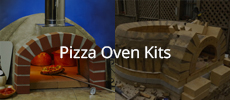Try here.
http://www.wellingtonpotterssupplies...uct-catalogue/.
Look in raw materials, you want ball clay FX $54/25 kg bag.
Announcement
Collapse
No announcement yet.
Clay Help!! Sodium Bentonite - New Zealand
Collapse
X
-
Thanks Utah,
Had a look into it without too much luck. Mostly beauty products.
I have however gone ahead and started digging my own. The best I could find locally was actually in my back yard, but it had a VERY high sand content. I ended up washing it and drying it. I think its almost ready to start pulverising.
Im looking forward to getting started
In the mean time friend has given me a lead on "fire clay" through a social club that operates in the area. Hopefully that pans out
Leave a comment:
-
What about kaolin? It is a product of NZ should be easily available, less costly, and in dry powder form.
Leave a comment:
-
Attempting to liquefy clay from a plastic state is quite difficult and takes a lot of energy and time mixing. It is far easier to break it into nothing larger than a fist then allow it to dry. Then when soaked in water it will break down readily into a thick slurry. Unfortunately it still requires lots of mechanical mixing to break down fine lumps of clay which you certainly don't want in your mortar. In addition you have to separate out any larger bits of foreign material. In this state a clay slip weighs around 1.8 kg/litre if that helps. I've processed tons of clay and made lots of slip and it is less work to simply pulverise dried clay to a powder and put it through a course seive.Originally posted by Toomulla View Post
I do not see why you need powdered clay the wet potters clay added to water and mixed to a slurry could be added to the mix water to incorporate into the home brew
If you can't obtain builders clay try pottery suppliers in Wellington, Waikato or Nelson.Last edited by david s; 03-07-2016, 11:01 PM.
Leave a comment:
-
Yeah true,
Good way of working it. Would only take on extra measurement to work the volume into the formular too!
I may just give that a whirl in conjunction with the water extraction mentioned above.
Leave a comment:
-
jes2xu, if you have a good scale, weigh a chunk of the wet clay, then dry it out (oven or whatever). Get a dry weight and you will have your ratio (hopefully your wet product is consistent, but if not just repeat the process for each new batch). You will probably have to hunt for a weight ratio for home brew, as the common one is by volume.
- Likes 1
Leave a comment:
-
I guess it becomes a issue of being able to get the right ratios? Weight will be totally thrown out due to the water content of the wet clay. Volume would be too, although to a lesser extent I guess?
But lets be honest . . . home brew is well . . . . home brew! Its not a exact science.
I agree in principle it should be exactly the same. Has anyone else tried this, or have a suggestion for getting close to the same ratio?Last edited by jes2xu; 03-07-2016, 03:52 PM.
Leave a comment:
-
I do not see why you need powdered clay the wet potters clay added to water and mixed to a slurry could be added to the mix water to incorporate into the home brewOriginally posted by jes2xu View PostHmmmm interesting.
Unfortunately I am "cutting" my bricks with a diamond blade on a grinder and a hammer and chisel. I was planning on using some of the off cuts though. breaking them down a bit and filling the larger gaps.
I called the local potter who has no powdered clay.
Guess I am digging the stuff
- Likes 1
Leave a comment:
-
I ran across a link some time back that I thought was very interesting. Practical Primitive shows a step by step "Water Extraction" method to remove the sediment. He is processing for pottery and only wants it to dry just enough for forming. I would imagine that after processing, it could be rolled out like dumplings to dry faster .
.
- Likes 1
Leave a comment:
-
Hmmmm interesting.
Unfortunately I am "cutting" my bricks with a diamond blade on a grinder and a hammer and chisel. I was planning on using some of the off cuts though. breaking them down a bit and filling the larger gaps.
I called the local potter who has no powdered clay.
Guess I am digging the stuff
Leave a comment:
-
Originally posted by JRPizza View PostJoe, didn't you and others use some of their residue from cutting bricks as a fireclay substitute in homebrew?
John,
Yes, I and several others have. I did not mention it because a wet saw with a water reservoir is critical to reclaiming the brick dust. And, it is not actually fire clay. But, I'm told that is close enough. I reclaimed mine from the settlings in my wet saw's reservoir. Once dried, I sifted it through an old window screen. Sieving it this way will yield a powder. However, some particles are about the same size as fine sand. I compensated by substituting a part of sand with another part of clay in the formula. I only tried to fit the inside joints of my build tightly. The outside joints were very large. I think that the large particles in the reclaimed clay are actually better for filling those spaces without shrinkage. To have enough reclaimed clay to get started, it would be best to cut the floor brick and the first row of dome brick. After that, there should be enough clay produced from the resevoir to stay ahead of the build. This is probably not what most builders do, but I only set my dome brick in place. I came back later and tuck pointed the large exterior gaps.Last edited by Gulf; 03-06-2016, 09:47 PM.
Leave a comment:
-
Try potters suppliers, they usually stock powdered clays for making slip bodies. Ask for a powdered earthenware clay, it should be cheaper. Crushed pumice would be good for an insulating mix, but not for a dense mix or mortar.
- Likes 1
Leave a comment:
-
Thanks guys,
I had initially thought of digging my own clay. But decided against it as I was warned about the amount of work it would take.
I decided not to do it as it would slow down the build (drying etc) but now I am still looking for the stuff and could have just started digging weeks ago haha. So perhaps its time to just do that!
Thoughts on crushed pumice instead of clay?
Thanks again
Leave a comment:
-
You can dig your own clay, but you will have to dry and pulverise it, then sift out rocks and impurities before adding it to any mix. Clay makes any mixture more refractory (fireproof) It will also improve the workability making any mix more sticky, but too much increases shrinkage which becomes a problem.Last edited by david s; 03-06-2016, 07:05 PM.
Leave a comment:





Leave a comment: